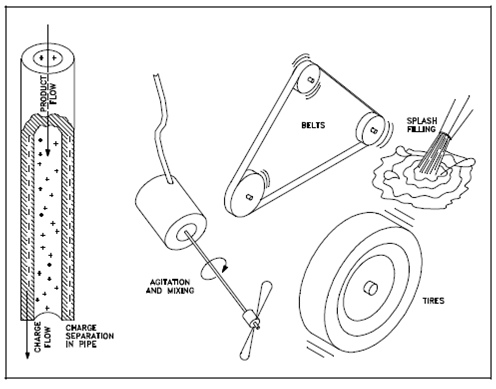Including Charge Separation in Pipe:
A point of great danger from a static spark is whereas a flammable vapor is present within the air, like as the outlet of a flammable liquid fill pipe at a delivery hose nozzle, close an open flammable liquid container, or around a tank truck fill opening. Within the presence of a mechanism for producing a static charge, a spark among two bodies occurs while there is a poor electrical conductive path among them. Therefore, bonding or grounding of flammable liquid containers is essential to avoid static electricity from causing a spark.

Figure: Typical Static-producing Situations, Including Charge Separation in Pipe
The word bonding and grounding have sometimes been used interchangeably since of a poor understanding of the terms. As described in Figure, a bonding eliminates a difference in potential among objects and grounding eliminates a difference in potential among an object and ground. The Bonding and grounding are effectual only while the bonded objects are conductive.
While two objects are bonded then the charges flow freely among the bodies, and there is no variation in their charge. Thus, the likelihood of sparking among them is eliminated.
While bonding eliminates a difference in potential among the objects which are bonded, it does not eliminate a difference in potential among these objects and the earth unless single of the objects possesses an adequate conductive path to earth. Thus, bonding will not eliminate the static charge, other than will equalize the potential among the objects bonded so which a spark will not occur among them.
An adequate ground will discharge a charged conductive body incessantly and is recommended as a safety measure while any doubt exists concerning a condition.